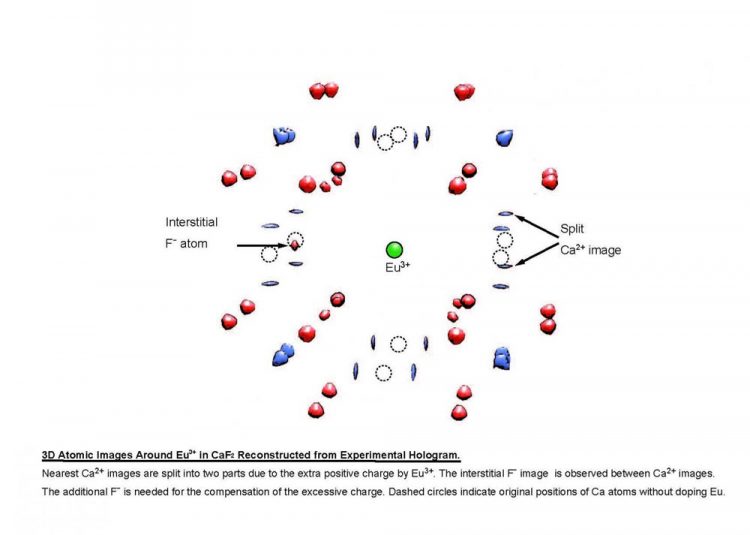New neutron holography technique opens a window for obtaining clear 3-D atomic images

Nearest Ca2+ images are split into two parts due to the extra positive charge by Eu3+. The interstitial F- image is observed between Ca2+ images. The additional F- is needed for the compensation of the excessive charge. Dashed circles indicate original positions of Ca atoms without doping Eu. Credit: NITech
However, X-rays are only sensitive to the number of electrons associated with an atom. This limits the use of X-rays for studying materials made up of lighter elements. Neutron measurements can often fill in the gaps in structures when X-ray measurements fail, but neutron beams are harder to make and have lower intensities than X-ray beams, which limits their versatility.
Now, a collaboration among Japanese researchers working at national particle accelerator facilities across Japan has developed a new multiple-wavelength neutron holography technique that can give insights into previously unknown structures.
They demonstrated a new neutron holographic method using a Eu-doped CaF2 single crystal and obtained clear three-dimensional atomic images around trivalent Eu substituted divalent Ca, revealing never-before-seen intensity features of the local structure that allows it to maintain charge neutrality.
“We knew that neutron holography might be able to tell us more about the structure of a europium-doped calcium fluoride crystal,” says lead author Kouichi Hayashi.
“Europium ions add extra positive charge to the crystal structure, and our neutron holograms showed how fluorine atoms arranged in the lattice to balance this excess charge. These kinds of structural problems are often encountered by materials scientists developing new electronic materials, and our method offers an exciting new tool for these researchers.”
The new holographic method works by firing neutrons with controlled speed at a sample, which in this case is the europium-doped calcium fluoride crystals. Neutrons are normally thought of as particles, but also have wave-like properties similar to light, depending on their speed.
When the neutrons hit europium atoms, gamma rays are produced in a pattern controlled by the local structure. The gamma ray patterns, or holograms, measured from neutrons travelling at different speeds are combined to produce a three-dimensional representation of the europium atoms in the crystal.
Hayashi says, “Neutron sources are less intense than X-ray sources, but it is essential that we work around this issue to develop more effective methods for exploring structures with light elements. Our work here represents a step towards a full toolbox of commentary X-ray and neutron techniques for materials research.”
Media Contact
All latest news from the category: Materials Sciences
Materials management deals with the research, development, manufacturing and processing of raw and industrial materials. Key aspects here are biological and medical issues, which play an increasingly important role in this field.
innovations-report offers in-depth articles related to the development and application of materials and the structure and properties of new materials.
Newest articles

Trotting robots reveal emergence of animal gait transitions
A four-legged robot trained with machine learning by EPFL researchers has learned to avoid falls by spontaneously switching between walking, trotting, and pronking – a milestone for roboticists as well…

Innovation promises to prevent power pole-top fires
Engineers in Australia have found a new way to make power-pole insulators resistant to fire and electrical sparking, promising to prevent dangerous pole-top fires and reduce blackouts. Pole-top fires pose…

Possible alternative to antibiotics produced by bacteria
Antibacterial substance from staphylococci discovered with new mechanism of action against natural competitors. Many bacteria produce substances to gain an advantage over competitors in their highly competitive natural environment. Researchers…





















